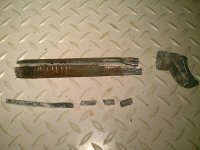superdave
10 mW
- Joined
- Apr 1, 2010
- Messages
- 28
I recently picked up an old cromoly frame mountain bike (an '87 Mongoose Altus) to use for my next ebike project. I figured the strong frame and big triangle (nice horizontal top tube) would make it an ideal donor, and I like the fact that it's a bit of a classic (Mongoose was a pretty respected brand before Pacific Cycles bought it). Plus, it was almost free  The bike was in fair condition (for being 25 years old); complete original components and a good solid frame. Disassembly went fine - cantilevers were pretty seized, but some liquid wrench and brute force solved that problem. Then I got to the seat post. I expected it to be seized (I've seen them seize in bikes only a couple years old) but figured "how bad can it be?" I found out!
The bike was in fair condition (for being 25 years old); complete original components and a good solid frame. Disassembly went fine - cantilevers were pretty seized, but some liquid wrench and brute force solved that problem. Then I got to the seat post. I expected it to be seized (I've seen them seize in bikes only a couple years old) but figured "how bad can it be?" I found out!
I started by filling the seat tube with ammonia and letting it sit for 24 hours hoping the acid would loosen things up. I put my 36" pipe wrench on the exposed post and gave it a good pull ... nothing. Perhaps not enough force. Went at it again with as much force as I could muster. I could feel the frame flexing (good thing it's steel), but the seat tube held fast. Plan B involved emptying a can of R134A onto the post to cool it down. Since Aluminum shrinks twice as much as steel when cooled, I though that would surely do it. Nope, big pipe wrench still wouldn't budge it. On to Plan C. I got some pure sodium hydroxide (lye) powder and mixed up a 50% solution. Sodium hydroxide is harmless to steel, but when combined with water it will react aggressively with aluminum. Three treatments, 36 hours, and a garage filled with hydrogen gas later I figured enough material would be dissolved to loosen the seat post. No such luck -- still just as stuck.
At that point, I sawed off the top of the seat post to see how much material was left. I was stunned to discover that instead of an aluminum pipe, I was dealing with a casting with an inside diameter that tapers down to a mere 10mm near the top (and that's after three days of NaOH treatment). So I now realize I'm dealing with 25 years of galvanic welding on a seat post with enough aluminum to support an elephant New plan is to break out a pack of hacksaw blades and start sectioning the post from the inside along it's length so I can chisel/pry out the sections (and hope that after one or two the rest of it breaks loose).
New plan is to break out a pack of hacksaw blades and start sectioning the post from the inside along it's length so I can chisel/pry out the sections (and hope that after one or two the rest of it breaks loose).
Let my experience be a warning to folks looking to use older bikes for ebike projects -- many problems on a bike can be pretty easily fixed, but a stuck seat post is not one of them.
I started by filling the seat tube with ammonia and letting it sit for 24 hours hoping the acid would loosen things up. I put my 36" pipe wrench on the exposed post and gave it a good pull ... nothing. Perhaps not enough force. Went at it again with as much force as I could muster. I could feel the frame flexing (good thing it's steel), but the seat tube held fast. Plan B involved emptying a can of R134A onto the post to cool it down. Since Aluminum shrinks twice as much as steel when cooled, I though that would surely do it. Nope, big pipe wrench still wouldn't budge it. On to Plan C. I got some pure sodium hydroxide (lye) powder and mixed up a 50% solution. Sodium hydroxide is harmless to steel, but when combined with water it will react aggressively with aluminum. Three treatments, 36 hours, and a garage filled with hydrogen gas later I figured enough material would be dissolved to loosen the seat post. No such luck -- still just as stuck.
At that point, I sawed off the top of the seat post to see how much material was left. I was stunned to discover that instead of an aluminum pipe, I was dealing with a casting with an inside diameter that tapers down to a mere 10mm near the top (and that's after three days of NaOH treatment). So I now realize I'm dealing with 25 years of galvanic welding on a seat post with enough aluminum to support an elephant
Let my experience be a warning to folks looking to use older bikes for ebike projects -- many problems on a bike can be pretty easily fixed, but a stuck seat post is not one of them.



